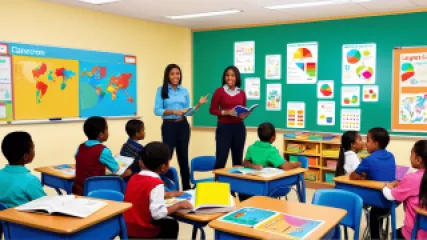The Complete Guide to Addressing Learning Disabilities
Learning disabilities can present significant challenges to individuals, impacting their ability to process and retain information. However, with the right support and strategies, those affected can achieve remarkable success. This guide aims to provide a comprehensive overview of addressing learning disabilities, offering insights into therapeutic techniques, counseling options, and solutions available online. By exploring various facets of learning disabilities, we hope to equip you with the knowledge needed to support those in need and foster a supportive environment for continuous growth.
Understanding Learning Disabilities
Learning disabilities are neurologically-based processing problems that can interfere with learning basic skills, such as reading, writing, and/or math. They can also hinder higher-level skills like organization, time planning, abstract reasoning, long or short-term memory, and attention. It's important to note that learning disabilities are not indicative of intelligence levels but rather how individuals process information.
Common Types of Learning Disabilities
There are several types of learning disabilities, each affecting different areas of learning and processing:
- Dyslexia: Affects reading and related language-based processing skills.
- Dyscalculia: Impacts mathematical calculations and concepts.
- Dysgraphia: Causes difficulties with writing, including handwriting, spelling, and organizing ideas.
- Auditory Processing Disorder (APD): Affects the interpretation of auditory information.
- Non-verbal Learning Disabilities: Impact non-verbal cues and spatial awareness.
Identifying Learning Disabilities
Early identification of learning disabilities is crucial for providing effective support. Parents, educators, and healthcare professionals need to be vigilant in recognizing the signs and symptoms of learning disabilities.
Signs and Symptoms
Individuals with learning disabilities may exhibit a variety of signs, including:
- Difficulty reading, writing, or performing arithmetic tasks.
- Problems with following directions or understanding instructions.
- Poor memory retention.
- Inconsistent academic performance.
- Struggles with organization and time management.
- Challenges in social interactions.
Assessment and Diagnosis
To accurately diagnose learning disabilities, a comprehensive assessment is necessary. This typically involves:
- Observations: Teachers and parents observe the child's behavior and performance in various settings.
- Screening Tests: Initial tests to identify potential areas of concern.
- Formal Evaluations: Conducted by educational psychologists or specialists to determine specific learning disabilities.
- Medical Evaluation: Rule out any underlying medical conditions that could affect learning.
Therapeutic Techniques for Learning Disabilities
Once a learning disability is identified, targeted therapeutic interventions can help individuals overcome challenges and improve their skills. Here are some effective techniques:
Individualized Education Programs (IEPs)
An IEP is a customized plan designed to meet the unique needs of a student with a learning disability. It includes specific goals, accommodations, and modifications to the curriculum to support the student's learning.
Multisensory Instruction
This approach engages multiple senses simultaneously to enhance learning. For example, teaching reading through visual aids, auditory input, and kinesthetic activities can be particularly effective.
Assistive Technology
Technology can play a pivotal role in supporting individuals with learning disabilities. Tools such as text-to-speech software, speech recognition programs, and interactive educational apps can aid in learning and comprehension.
Cognitive Behavioral Therapy (CBT)
CBT can help individuals develop coping strategies, improve self-esteem, and manage anxiety related to learning challenges. It focuses on changing negative thought patterns and behaviors.
Occupational Therapy
Occupational therapists work with individuals to develop fine motor skills, improve hand-eye coordination, and enhance organizational abilities, thereby facilitating better academic performance.
Learning Disabilities Counseling
Counseling can provide emotional and psychological support to individuals with learning disabilities, helping them navigate their challenges more effectively.
Role of a Learning Disabilities Counselor
A learning disabilities counselor works with individuals to:
- Identify strengths and weaknesses.
- Develop personalized coping strategies.
- Provide guidance on academic and career planning.
- Offer emotional support and build self-confidence.
Types of Counseling Approaches
Several counseling approaches can be beneficial for individuals with learning disabilities:
- Cognitive Therapy: Focuses on changing negative thought patterns.
- Behavioral Therapy: Aims to modify harmful behaviors and develop positive habits.
- Family Therapy: Involves family members to create a supportive home environment.
- Group Therapy: Provides a platform for individuals to share experiences and learn from each other.
Supporting Learning Disabilities at Home
Parents and caregivers play a crucial role in supporting children with learning disabilities. Creating a conducive home environment can significantly impact their development.
Creating a Structured Environment
Establishing a routine and organized space for studying can help individuals with learning disabilities stay focused and reduce distractions.
Encouraging Open Communication
Maintaining open lines of communication with your child can help identify their needs and provide emotional support. Encourage them to express their feelings and concerns.
Using Positive Reinforcement
Positive reinforcement, such as praise and rewards, can motivate individuals to persevere through challenges and build self-confidence.
Seeking Professional Support
If needed, don't hesitate to seek help from professionals, such as tutors, therapists, or counselors, who specialize in learning disabilities.
Learning Disabilities Solutions Online
The digital age has brought about numerous online resources and solutions to support individuals with learning disabilities. These tools can provide additional support and enhance learning experiences.
Online Tutoring Services
Many online platforms offer specialized tutoring services tailored to the needs of individuals with learning disabilities. These services can provide personalized instruction and flexible scheduling.
Educational Apps and Software
Interactive educational apps and software can make learning more engaging and accessible. Some popular options include:
- Khan Academy: Offers free, high-quality educational content across various subjects.
- Read&Write: Assists with reading, writing, and comprehension through text-to-speech and other tools.
- Mathway: Provides step-by-step solutions to mathematical problems.
Virtual Support Groups
Joining online support networks can provide a sense of community and shared experiences. These groups offer a platform to exchange tips, seek advice, and gain emotional support.
Building a Learning Disabilities Support Network
Establishing a strong support network is essential for individuals with learning disabilities. This network can include family, friends, educators, and professionals who work together to provide comprehensive support.
Engaging with Educators
Building a collaborative relationship with teachers and school staff is crucial. Regular communication ensures that everyone is on the same page and working towards common goals.
Connecting with Other Parents
Joining local or online parent groups can provide valuable insights and resources. Sharing experiences with other parents can offer new perspectives and strategies.
Seeking Professional Guidance
Professionals, such as educational psychologists, therapists, and counselors, can offer expert advice and support. Regular consultations can help monitor progress and adjust strategies as needed.
Case Studies: Successful Strategies for Addressing Learning Disabilities
Exploring real-life case studies can provide inspiration and practical insights into addressing learning disabilities. Here are a few examples:
Case Study 1: Overcoming Dyslexia with Multisensory Instruction
Benjamin Davidson was diagnosed with dyslexia at a young age. With the help of multisensory instruction, incorporating visual, auditory, and kinesthetic learning, Benjamin improved his reading skills significantly. His teachers used techniques such as tracing letters in sand, listening to phonics songs, and using flashcards to reinforce learning.
Case Study 2: Success with Assistive Technology for Dysgraphia
Elijah Carroll struggled with dysgraphia, making writing tasks challenging. His school introduced assistive technology, including speech-to-text software and word prediction tools. These resources enabled Elijah to focus on expressing his ideas without being hindered by handwriting issues. As a result, his written assignments improved markedly, boosting his confidence.
Case Study 3: Cognitive Behavioral Therapy for Auditory Processing Disorder
Amari Kim faced difficulties with auditory processing, affecting her ability to follow verbal instructions. Through cognitive behavioral therapy (CBT), she learned coping strategies to manage anxiety and improve concentration. CBT sessions helped Amari develop techniques to break down complex instructions into manageable steps, enhancing her overall academic performance.
Future Trends and Innovations in Addressing Learning Disabilities
The landscape of learning disabilities is continually evolving, with new research and innovations emerging. Staying informed about these trends can help provide the most effective support.
Advances in Neuroplasticity Research
Neuroplasticity, the brain's ability to reorganize itself by forming new neural connections, holds promise for addressing learning disabilities. Emerging research suggests that targeted interventions can harness neuroplasticity to improve cognitive functions.
Artificial Intelligence in Education
Artificial intelligence (AI) is revolutionizing education by providing personalized learning experiences. AI-driven tools can adapt to individual needs, offering customized content and real-time feedback, thus supporting students with learning disabilities more effectively.
Virtual Reality (VR) for Skill Development
Virtual reality (VR) technology is being explored as a tool for skill development and immersive learning experiences. VR can create engaging environments for practicing social skills, spatial awareness, and other critical abilities.
Conclusion: Embracing a Holistic Approach
Addressing learning disabilities requires a multifaceted approach that combines therapeutic techniques, counseling, and a robust support network. By understanding the unique challenges and strengths of individuals with learning disabilities, we can create an inclusive environment that fosters growth and success.
Whether through individualized education programs, assistive technology, or online solutions, there are numerous resources available to support those with learning disabilities. By staying informed about the latest trends and innovations, we can continue to improve our strategies and provide the best possible support.
Ultimately, the journey of addressing learning disabilities is one of collaboration, empathy, and perseverance. By working together, we can empower individuals with learning disabilities to reach their full potential and thrive in all aspects of life.
Additional Resources
For those seeking further information and support, consider exploring the following resources:
- Local educational institutions and support centers.
- Online forums and support groups for parents and individuals with learning disabilities.
- Professional organizations specializing in learning disabilities.
- Books and publications on therapeutic techniques and strategies for learning disabilities.
Remember, every individual's journey is unique, and with the right support, overcoming learning disabilities is entirely possible.






